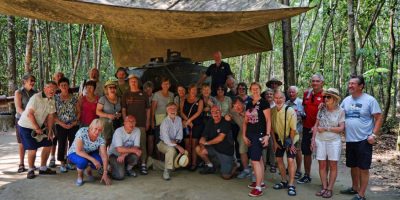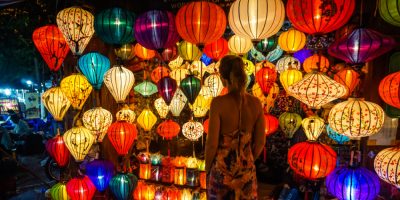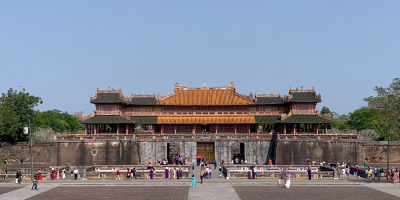
My Son Sanctuary – World Heritage UNESCO
- North latitude: 15o505
- East longitude: 108o573
- Total Area: 1.158 ha
- Location: Duy Phu Commune, Duy Xuyen District, Quang Nam province
My Son Sanctuary – Your Ultimate Guide To Visiting My Son Holy Land
- 1. Introduction
- 2. History and Architecture of My Son Sanctuary
- 3. Exploring My Son Sanctuary
- 4. How to Get to My Son Holy Land
- 4.1 Hoi An to My Son by Private Car
- 4.2 by Motorbike
- 5. Best Time to Visit My Son Holy Land
- 6. My Son Sanctuary Entrance Fee
- 7. My Son Sanctuary Tours
- 7.1 Small Group Tour
- 7.2 My Son Holy Land Private Tour
Nestled amidst lush greenery, My Son Sanctuary offers a captivating journey into the past. Visitors can explore the remnants of the once-thriving Cham Empire, marvel at the intricate stone carvings, and witness the grandeur of red brick temples.
If you’re planning a trip to Vietnam, then you should definitely add My Son Sanctuary to your list of places to visit. This ancient temple complex is one of the country’s most important cultural sites, and it offers a fascinating glimpse into the region’s rich history.
In this article, we’ll take a closer look at My Son Sanctuary, exploring its history, architecture, and significance.
1. Introduction
My Son Sanctuary is a UNESCO World Heritage Site, and it is considered to be one of Vietnam’s most important cultural landmarks. The site’s significance lies in its historical, architectural, and cultural value, as it provides a glimpse into the Champa civilization’s rich and fascinating history.

2. History and Architecture of My Son Ruins
My Son Sanctuary history
My Son Sanctuary was constructed between the 4th and 14th centuries by the Champa civilization, which ruled over Central Vietnam for more than a thousand years. The site was a center for both religious and political activities, and it served as a place of worship for the Champa kings and their subjects.
Over time, My Son Sanctuary grew to become a vast complex of over 70 temples and other structures, with each building representing a different period in the Champa civilization’s history. Unfortunately, much of the site was destroyed during the Vietnam War, but a significant portion of it has been restored, providing visitors with a fascinating insight into this ancient culture.

Architecture
The temples of My Son Sanctuary are a beautiful blend of Hindu and Buddhist architectural styles, which reflect the Champa civilization’s religious and cultural beliefs. The buildings are constructed from red bricks and sandstone, and they are adorned with intricate carvings and sculptures that depict scenes from Hindu and Buddhist mythology.
One of the most striking features of My Son Sanctuary is the intricate decorations on the temples’ roofs, which are covered in ornate carvings of sacred animals, including dragons, lions, and elephants. These carvings are a testament to the Champa civilization’s artistic and architectural skill, and they are truly breathtaking to behold.
3. Exploring My Son Ruins
If you’re planning a visit to My Son Sanctuary, there are plenty of ways to explore this fascinating site. Guided tours are available, and they offer a wealth of information about the temples’ history and significance. Alternatively, you can explore the site on your own, wandering through the ruins and marveling at the intricate carvings and sculptures.
Be sure to bring plenty of water and wear comfortable shoes, as the site is quite extensive, and you’ll want to take your time exploring all that it has to offer. And don’t forget your camera, as the temples of My Son make for some truly stunning photo opportunities.

4. How to Get to My Son Holy Land
4.1 Hoi An to My Son by Private Car
If you’re planning a trip from Hoi An to My Son Ruins, taking a Private Car is a convenient and comfortable option. Taking a private car allows you to travel at your own pace, stopping along the way to take in the sights or grab a bite to eat.
When booking a private car, be sure to choose a reputable provider with a well-maintained vehicle and an experienced driver. You may also want to consider booking a guided tour, which can provide you with a wealth of information about the history and significance of My Son.
4.2 by Motorbike
Riding a motorbike allows you to enjoy the stunning scenery at your own pace, with the wind in your hair and the sun on your face. You can also take detours and explore hidden gems along the way, stopping whenever you like to take photos or grab a bite to eat.
5. Best Time to Visit My Son Holy Land
My Son Holy Land is a popular tourist destination in Vietnam and is best visited during certain times of the year to ensure the most enjoyable and comfortable experience. The best time to visit My Son Holy Land is from February to May when the weather is dry and the temperature is mild.
However, if you prefer cooler temperatures, visiting My Son Holy Ruinsin the winter months (from November to January) is also an option. While temperatures can drop to around 10 degrees Celsius during this time, the weather is generally dry and sunny, making it an ideal time to explore the ruins.

6. My Son Sanctuary Entrance Fee
If you’re planning a visit to My Son Ruins, it’s important to know the Entrance Fee to ensure that you have enough money with you. As of 2023, the entrance fee for My Son is 150,000 VND (approximately $6.5) per person.
It’s also important to keep in mind that prices can change over time, so it’s a good idea to double-check the current Entrance Fee before your visit. Additionally, some tour providers may include the entrance fee in their package price, so be sure to check with your provider if you’re booking a guided tour to My Son.
7. My Son Sanctuary Tours
7.1 My Son Ruins Group Tour
If you’re interested in exploring My Son and meeting other travelers, joining a group tour can be a fun and informative option.
Group tours to My Son Ruins typically include transportation from Hoi An, admission fees, and a guided tour of the site. Some tours may also include additional stops or activities, such as a boat trip or a traditional Vietnamese lunch.
One of the main advantages of taking a group tour is the opportunity to meet other travelers and share your experiences. You may find that you have a lot in common with your fellow tour members and can exchange tips and recommendations for other things to see and do in Hoi An and beyond.

7.2 My Son Sanctuary Private Tour
If you’re looking for a more personalized and flexible experience at My Son Sanctuary, booking a Private Tour can be an excellent option. Private tours allow you to customize your itinerary, choose your own pace, and have the undivided attention of your guide.
Your guide can provide you with in-depth information about the history and significance of My Son, answer any questions you may have, and ensure that you have a safe and enjoyable experience.










Comment (0)